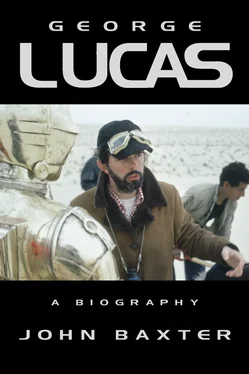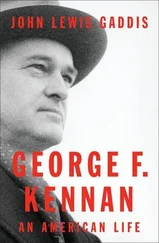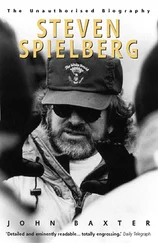1 ...6 7 8 10 11 12 ...33 Lucas’s one aptitude was art. At home, he drew elaborate panoramas, and labored over hand-crafted greeting cards. ‘I had a strong interest even in high school in going to art school and becoming an illustrator,’ he says, ‘but my father was very much against it. Said I could do it if I wanted to, but he wasn’t going to pay for it. I could do it on my own.’ Teachers were no more encouraging. Schoolmate Wayne Anderson remembers the art teacher snapping, ‘Oh, George, get serious,’ when she found he’d ignored the subject assigned and had instead sketched a pair of armored space soldiers.
When he was fifteen, George’s life underwent a fundamental disturbance. Modesto was spreading as fruit-growers sold their orchards for building lots, and planted less fragile and labor-intensive crops. In 1959, George Sr bought thirteen acres under walnut trees at 821 Sylvan Road, on the outskirts of town, and moved his family into a ranch house on the property. George loathed his new home, which cut him off from all his friends. Until he could get his driver’s license and, more important, a car, he was a prisoner. When school ended each afternoon at 3 p.m., he rode his bike or took the school bus home, went straight to his room and spent the hours before dinner reading comics and playing rock’n’roll. Emerging, he’d eat in silence, watching the family’s Admiral TV, which, fashionably for the time, sat on a revolving ‘Lazy Susan’ mount that swivelled through 360 degrees. After that, it was back to his room again. Hoping to revive his son’s interest in construction, Lucas Sr designed a large box, with a glass top and front, in which he could continue to create his imaginary battlefields. He gave him a 35mm camera for his birthday, and turned the house’s second bathroom into a dark room. But while George fitfully pursued these enthusiasms, his heart was no longer in them. He was fifteen – in America, the age when a young man’s fancy lightly turns to thoughts of wheels.
When America went to war, the car industry was one of the first to be militarized. The Japanese bombed Pearl Harbor in December 1941. By February 1942, every automotive assembly line in America had been turned over to tanks. The government impounded any cars Detroit had in stock, and doled them out to the military and to people in protected occupations. By 1945, the supply of new cars was down to thirty thousand – three days’ worth by 1939 rates of sale. The shortage didn’t ease for five years, when the government permitted the importation of a few vehicles from Europe, almost entirely luxury cars like the Rolls-Royce, Jaguar, or Bentley, or, at the other end of the market, the Volkswagen and the Fiat Innocenti and the Autobianchi – the kind of ‘toy’ cars with which Detroit, still committed to the gas-guzzler, refused to soil its hands. (Curt Henderson in American Graffiti drives a clapped-out Citroën Deux Chevaux .) The occasional independent, like Preston Tucker, who tried to build and sell cars in competition with Detroit was ruthlessly put down.
‘If you didn’t have a car back then,’ says Modestan Marty Reiss, ‘basically you didn’t exist.’ Lucas agrees: ‘In the sixties, the social structure in high school was so strict it didn’t really lend itself to meeting new people. You had the football crowd and the government crowd and the society-country-club crowd, and the hoods that hung out over at the hamburger stand. You were in a crowd and that was it. You couldn’t go up and you couldn’t go down. But on the streets it was everyone for himself, and cars became a way of structuring the situation.’
If a kid couldn’t afford a VW or Fiat, he grabbed what he could, and adapted it. Four years of tinkering, repairing and making-do, added to the repair skills expected of kids who often needed to service farm machinery, had turned farm boys into fair auto mechanics. Prewar Detroit made its cars as simply as possible, to standardize spare parts. Two rusting wrecks might be cobbled together into one vehicle. During the war, undertakers could still buy hearses. Ranchers usually got a station wagon, farmers a pick-up. All were ingeniously adapted in the late forties and early fifties.
Surfers liked the long vehicles, ideal for carrying boards, but kids looking for something hot sought out the 1932 Ford Deuce Coupe and the ’47 Chevrolet, which they ‘chopped’ – lowering the roof as close to the hoodline as possible – and ‘channelled’ – dropping the body down between the wheels. Playing with the suspension could make the car look nose- or tail-heavy, or simply close to the ground in general: the ‘low rider’ look that signalled a driver looking for trouble. (In American Graffiti , John Milner reassures a cop that his front end is the regulation 12½ inches above the road.) Fitted with an engine souvenired from some much heavier car, with a ground-scraping new suspension, the low roofline giving the divided windscreen the look of threatening slit eyes, all the chrome stripped off, door handles removed, only the legal minimum of lights retained, and the whole thing repainted yellow, with flames down both sides, Grandpa’s 1932 Ford became that most ominous of post-war cultural artefacts, the hot-rod.
One end of the post-war car world was represented by customizers like George Barris, who turned Cadillacs into lavish display vehicles for Hollywood stars, with lashings of chrome, iridescent and multiple-layered lacquer finishes, and whorehouse interiors upholstered in animal skin, velvet or fur. At the other extreme was Junior Johnson, a North Carolina country boy who dominated the dirt-track circuits of the rural South, winning such a reputation that Detroit and the tire and gas companies began investing in the burgeoning worlds of stock cars and hot-rods.
Long, straight country roads offered the perfect laboratory for testing and perfecting often bizarrely adapted vehicles. The mythology of cars flourished particularly in predominantly white Northern California. Black musicians seldom sang about cars, but white ‘surfer’ groups like Jan and Dean and, particularly, the Beach Boys made them a staple. The latter’s ‘Little Deuce Coupe,’ ‘Shut Down’ and ‘409’ – named for the cubic-inch displacement of a Chevrolet engine – were major hits.
All over Stanislaus County, kids worked on their cars through the week and, on Saturdays, brought them to downtown Modesto, where they took advantage of the one-way system imposed by merchants to make a leisurely tour d’honneur along Tenth Street, across one block, down Eleventh and onto Tenth again.
Lucas said later, ‘When I was ten years old, I wanted to drive in Le Mans and Monte Carlo and Indianapolis,’ but his real interest in cars actually began when he was around fifteen, and became a ruling passion. On any Saturday from 1959 onwards, you could have found him on Tenth Street from around four in the afternoon to well after midnight.
Cruising in Modesto had a lot to do with sex, but, though Lucas claimed he lost his virginity in the back of a car with a girl from Modesto High, the tougher and more sexually active of the town’s two high schools, nobody has ever admitted to being his girl. John Plummer recognizes a lot of Lucas in the inept teenager played by Charles Martin Smith in American Graffiti : ‘There’s so much of George in Terry the Toad it’s unbelievable. The botching of events in terms of his life, his social ineptness in terms of dealing with women.’ His mother said, ‘George always wanted to have a blonde girl friend, but he never did quite find her.’ In Graffiti , Terry, who normally bumbles around on a Vespa scooter, inherits the car of his friend Steve Bolander when Steve goes off to college, and immediately snags Debbie (Candy Clark), the most bubble-headed blonde anyone could desire.
Читать дальше












